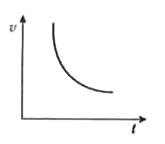Which of the following is the graph between the time and the velocity of a body moving in a viscous fluid?




The correct Answer is:A
To determine the graph between time and velocity of a body moving in a viscous fluid, we need to analyze the motion of the body as it falls through the fluid.
1. Understanding Forces Acting on the Body:
- When a body is dropped into a viscous fluid, three primary forces act on it:
- The gravitational force (weight) Fg=mg
- The buoyant force Fb
- The viscous drag force Fv=6πηrv
- Here, η is the viscosity of the fluid, r is the radius of the body, and v is the velocity.
2. Initial Conditions:
- Initially, when the body is dropped, the gravitational force is greater than the sum of the buoyant force and the viscous force. Thus, the body accelerates downwards.
3. Velocity Increase:
- As the body descends, the velocity increases due to the net force acting on it. The net force can be expressed as:
Fnet=Fg−Fb−Fv
- As the velocity increases, the viscous force Fv also increases.
4. Reaching Terminal Velocity:
- Eventually, the body will reach a point where the net force becomes zero. This occurs when the gravitational force is balanced by the sum of the buoyant force and the viscous force:
mg=Fb+Fv
- At this point, the body stops accelerating and moves with a constant velocity known as the terminal velocity vt.
5. Graphical Representation:
- The graph of velocity vs. time will show an initial increase in velocity as the body accelerates, followed by a plateau where the velocity remains constant (terminal velocity).
- Therefore, the graph will start from the origin, rise sharply, and then level off as it approaches terminal velocity.
6. Conclusion:
- Based on the analysis, the correct graph representing the relationship between time and velocity for a body moving in a viscous fluid is a graph that initially increases and then levels off, indicating the attainment of terminal velocity.
Correct Option:
- The correct option is A.
- When a body is dropped into a viscous fluid, three primary forces act on it:
- The gravitational force (weight) Fg=mg
- The buoyant force Fb
- The viscous drag force Fv=6πηrv
- Here, η is the viscosity of the fluid, r is the radius of the body, and v is the velocity.
- Initially, when the body is dropped, the gravitational force is greater than the sum of the buoyant force and the viscous force. Thus, the body accelerates downwards.
- As the body descends, the velocity increases due to the net force acting on it. The net force can be expressed as:
Fnet=Fg−Fb−Fv
- As the velocity increases, the viscous force Fv also increases.
- Eventually, the body will reach a point where the net force becomes zero. This occurs when the gravitational force is balanced by the sum of the buoyant force and the viscous force:
mg=Fb+Fv
- At this point, the body stops accelerating and moves with a constant velocity known as the terminal velocity vt.
- The graph of velocity vs. time will show an initial increase in velocity as the body accelerates, followed by a plateau where the velocity remains constant (terminal velocity).
- Therefore, the graph will start from the origin, rise sharply, and then level off as it approaches terminal velocity.
- Based on the analysis, the correct graph representing the relationship between time and velocity for a body moving in a viscous fluid is a graph that initially increases and then levels off, indicating the attainment of terminal velocity.
- The correct option is A.
Topper's Solved these Questions
- FLUIDSBOOK - RESNICK AND HALLIDAYCHAPTER - FLUIDSEXERCISE - PRACTICE QUESTIONS (More than One Correct Choice Type )
10 Videos
- FLUIDSBOOK - RESNICK AND HALLIDAYCHAPTER - FLUIDSEXERCISE - PRACTICE QUESTIONS (Linked Comprehension )
9 Videos
- FLUIDSBOOK - RESNICK AND HALLIDAYCHAPTER - FLUIDSEXERCISE - PROBLEMS
68 Videos
- ELECTROMAGNETIC WAVES BOOK - RESNICK AND HALLIDAYCHAPTER - ELECTROMAGNETIC WAVES EXERCISE - PRACTICE QUESTIONS (Integer Type)
3 Videos
- FORCE AND MOTION - I BOOK - RESNICK AND HALLIDAYCHAPTER - FORCE AND MOTION - I EXERCISE - PRACTICE QUESTIONS (Integer Type)
3 Videos
Similar Questions
Knowledge Check
From the following displacement-time graph find out the velocity of a moving body.
 A1√3m/sB3m/sC√3m/sD13m/s
A1√3m/sB3m/sC√3m/sD13m/sFrom the following displacement-time graph find out the velocity of a moving body
 A1√3m/sB3 m/sC√3 m/sD13 m/s
A1√3m/sB3 m/sC√3 m/sD13 m/sA body nis thrown vertically upward. Which of the following graphs correctly/represents the velocity of the body with time?
A B
B C
C D
D
Which of the following velocity-time graphs shows a realistic situation for a body in motion ?
View SolutionWhich of the following velocity-time graphs shows a realistic situation for a body in motion ?
View SolutionFor which of the following graphs the average velocity of a particl moving along a straight line for time interval (0,t) must be negative−
View SolutionWhich of the graph between velocity and time is correct ?
View SolutionWhich of the following graphs represents the position time-graph of a particle moving with negative velocity?
View Solution
